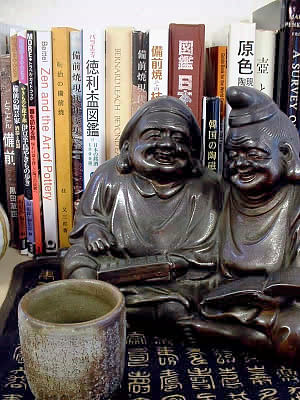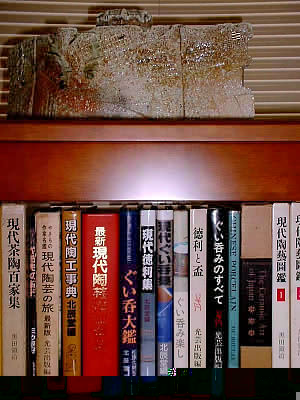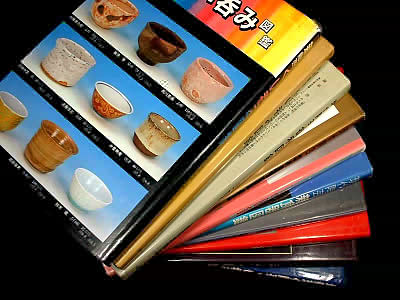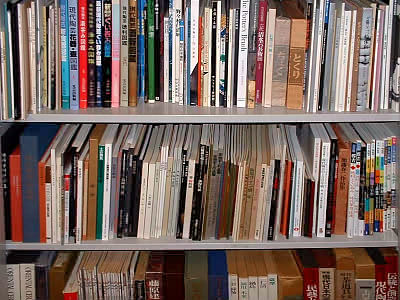|



Released July 26, 2004
Below Story Published by Yakimono.net November 2002

Meiji Period Bizen -- Ebisu and Daikoku
Guinomi by Takahara Satoshi -- the Heart Sutra is etched on it
Books -- I've learned so much about Japanese pottery from them. Some are in English, like Koyama Fujio's "The Heritage of Japanese Ceramics (buy at Amazon)," which was first published in 1973. The Japanese original was published in 1967 and was titled "Nihon Toji no Dento." There are a few others, yet good books on the subject in English are far and few between.
|
BOOKS BY
RICHARD WILSON
click to buy
at Amazon

 |
|
A few of the better ones were written by Professor Richard Wilson of the International Christian University and include "Inside Japanese Ceramics" and "The Potters Brush." The latter is an exhibition catalog that deals with works by Ogata Kenzan and his followers in the collection of the Freer Gallery of Art and Arthur M. Sackler Gallery, Smithsonian Institution, Washington, D.C. To learn more about author Richard Wilson, click here for an EY-NET interview with this pottery historian.
The majority of the books in my library are in Japanese though. I must add that my reading in Japanese is just so-so, and I relied so much on photos when I first started looking at books way back in 1984. As the saying goes, "A picture is worth a thousand words" and in the case of looking at shuki (sake vessels) this proves to be oh so true. Back in those days, Kogei Shuppan-sha (a publishing company) was putting out many "picture" books that were immensely helpful to me. They allowed me to see many styles, learn potter's names, prices, and most importantly, to assist me in developing an eye.
I have all the picture books from that period. Some are about yunomi, others on tea wares, and some on tablewares. Yet, the ones that have dirt, grit, and finger markings all along them are the shuki books. For years, I never watched television but each night poured over the photos in the books.

Piece at top is a henko by Nagaoka Masami
In particular is the Showa 59 (1984) book entitled "Shin Gendai Tougei Guinomi Zukan" -- how I love that book (see below photo). In my opinion it is better than the previous guinomi book by the same publisher titled "Gendai Tougei Guinomi Zukan" which was first published in Showa 56 (1981).

Book on top of pile is Shin Gendai Tougei Guinomi Zukan
I value that book also very much and was lucky enough to get a few guinomi that are pictured inside. Acquiring these published works was all just coincidence, or more likely de-ai; as with anything in life, it's all de-ai (which means "fortunate encounters"). The guinomi that I treasure most is pictured on page five (top row, middle piece). It's a fabulous neriage piece by the late Ueda Tsuneji. It is simply magical and sake magnifies the details quite nicely. I have never seen another neriage guinomi like it since. I would also love to have the Mori Togaku guinomi pictured next to Ueda find me! "Hey, Togaku guinomi, I know you're out there somewhere -- come find me!" Yet, I also know that de-ai cannot be forced, so I will wait patiently.

Center guinomi by Ueda Tsuneji
After I found out about these shuki books, I headed off to Jinbocho in Tokyo, for the bookstores in Numazu (where I live) are so limited. Plus, there was no Internet back then. But now, books can be bought from anywhere at anytime. In Jinbocho, I also found "Guinomi no Subete," "Guinomi Tanoshi," and "Tokkuri to Sakazuki," all published by Kogei Shuppan-sha. I am very thankful that Kogei put out such books for in a large way they were my teachers. Of course, other books followed and the special magazine issues, like Taiyo's great "Tokkuri and Sakazuki," published in 1994. Oh, the masterpieces pictured there! It was a feast for my eyes, and still is.

Books in Yellin's Pottery Library
So, for all you shuki lovers out there -- nothing beats holding, and using, the real things. Yet, when television can be so boring, and the night is young and there's not much to do, a good shuki book makes very fine company indeed.
LEARN MORE ABOUT BOOKS ON POTTERY
|